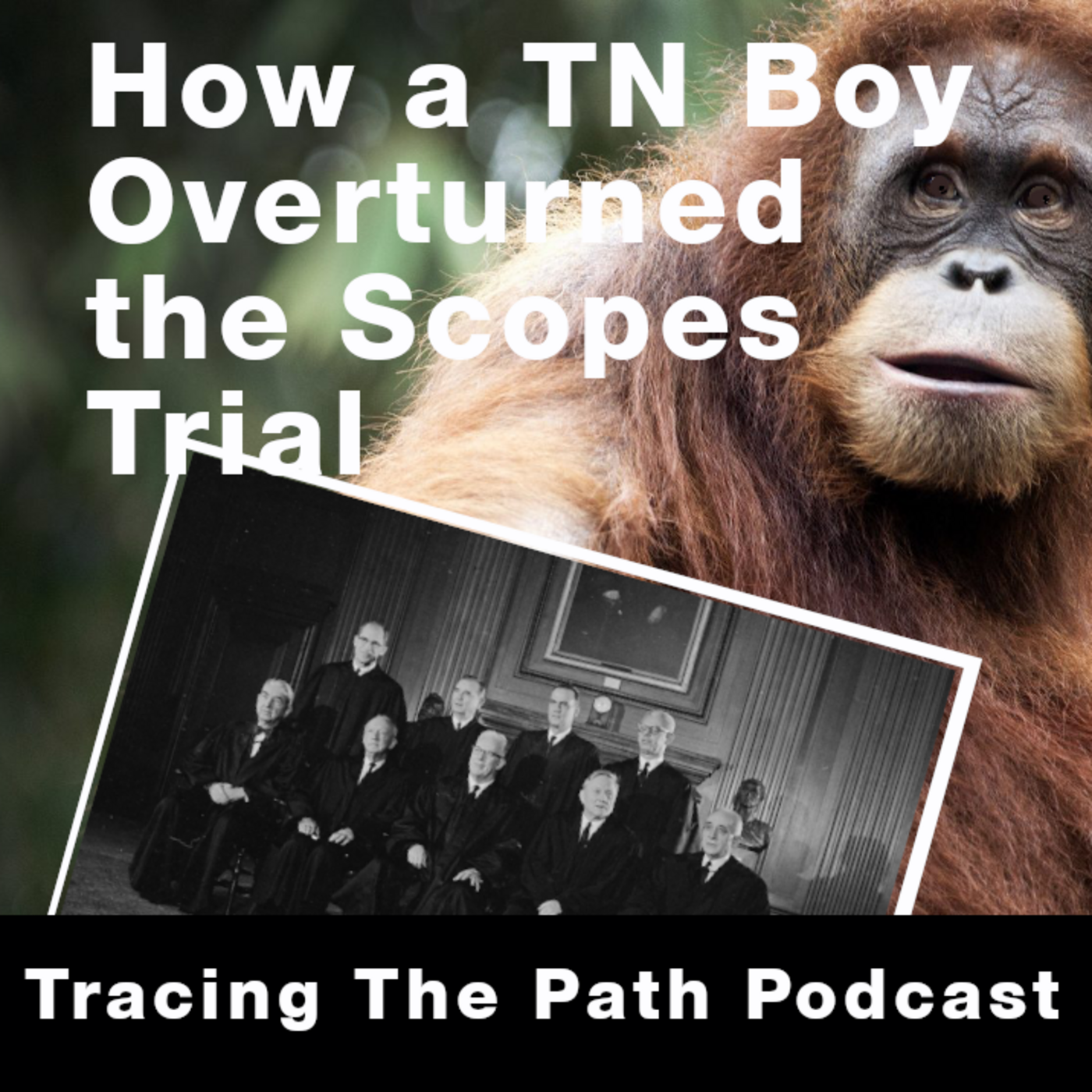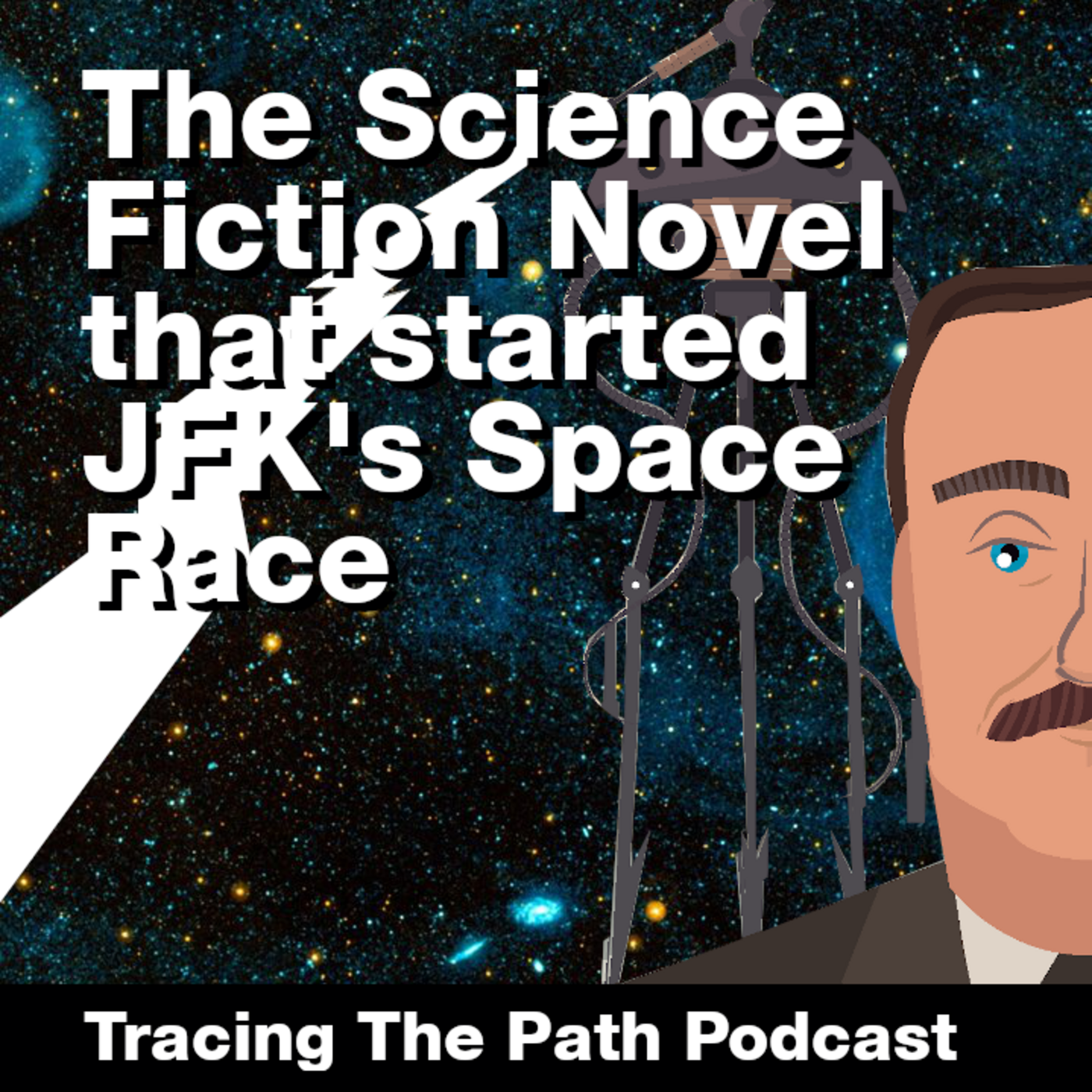TRACING THE PATH PODCAST

The Blue Jeans that Got Away With Murder
This episode explores the multifaceted history and pervasive influence of the color blue, particularly in the context of fabric dyes. It traces the evolution of blue pigments from Sir Isaac Newton’s color theories and early natural dyes like woad and indigo, highlighting their economic and social impact through global trade and colonial expansion.
The story then shifts to the invention of durable blue work pants by Jacob Davis and Levi Strauss, detailing how the use of rivets and “Serge de Nîmes” (denim) revolutionized everyday clothing. Finally, the source delves into the development of synthetic blue dyes, including Prussian blue and the commercially viable synthetic indigo pioneered by BASF, controversially noting the latter’s dark involvement in World War II atrocities.

Audio Hour:
If you run an activity group, classroom or “audio book club”, click here for more information on using Tracing The Path.
Throughout the episodes, every tune is somehow related to the topic. In the Twinkies episode, for instance, the discussion of the Brooklyn Tip-Tops Baseball team concludes with “Take Me Out To the Ballgame”.
How many do you recognize? And harder, how many can you name?

The flowering plant Woad
The Blue Jeans that Got Away With Murder
In 1702, Sir Isaac Newton started investigating light and color. Using prisms, he determined red, yellow, and blue to be the primary colors. And also determined orange, green, and violet to be the secondary colors, a total of 6.
But because he thought the number 7 was powerful, he arbitrarily added a 7th color to the color wheel. That color, represented in the acronym Roy G. Biv, is Indigo. You’ll never actually see Indigo in a rainbow, but the color did change the world.
Welcome to Tracing the Path.
Newton is mainly remembered for his three laws of motion, but his work in light and color is groundbreaking as well. Perhaps his most important observation was that color was largely a factor of light. While there were many pigments for some colors, the world was searching for a reliable, economical, blue pigment.
There were a few, but each came with its own complications.
The mustard family of plants provided one called woad. The mustards included cabbage, kale, cauliflower, broccoli, and radish, among others. One of those is a medicinal plant with the yellow flowers, called Isatis Tinctoria, but most call it Woad.
Not only was it medicinal, but properly processed, its leaves were used to make a blue dye.
Historians have found evidence of woad in Egyptian mummy cloths, and there are historical references by Julius Caesar and in poems of William Chaucer. Woad wasn’t the longest lasting die or the richest blue, but it was the most economical at the time.
By medieval times, France had become the primary hub of trade for woad, but you could find it in any of the cities, along the silk road routes, cities like Genoa, Italy, Nîmes France, and Dungari, India. While woad was traded globally for the art and textile industries, they also fueled the trade of fabrics. Fabrics bought for the purpose of dying, and those died in the wool. But the nature of global trade and a naturally grown product, the supply of woad always fluctuated.
For instance, many countries experienced widespread famines in the 16th century. In England, the cultivation of woad was temporarily banned, as farmers were ordered to grow food products. Other times, droughts slowed down the production of woad.
But the other options weren’t necessarily better.
The Blue Pigments
As early as 2200 BC, the Egyptians had created a blue pigment, which has been labeled Egyptian Blue. They heated a mixture of limestone, sanded copper, to make a blue glass, and then crushed it into a dye. They painted ceramics, statues, and tombs. The color was a light blue or cornflower.
A more vibrant blue popped up after that, ultra-marine blue. It was made from the gemstone Lapis Lazuli, which was found in the mountains of Afghanistan. The blue was highly coveted by artists even today. But the cost of harvesting it meant it was primarily reserved for the wealthy.
And even those artists reserved it for their most important commissions. Michelangelo couldn’t even finish his painting The Entombment, because he couldn’t afford ultramarine to finish it.
In the sixth century, China began importing cobalt from Persia and used it in their pearl white ceramics, as well as in jewelry.
Finally, another plant, one native to southern India, produced a blue pigment as well. Indigofera Tinctoria grows primarily in the tropical and near tropical environments. It produced a color similar to woad and was largely used in inks and in paints. But when famine hit Europe and they had to begin importing woad, Indigo started to be used in dying fabrics.
But woad farmers all over Europe stood up against its importation. The woad farmers in France even convinced the French government to ban Indigo imports in the early 1600s. Nevertheless, it was more cost-efficient than woad and became the primary fabric dye in the rest of the world.
By the time European colonization began, indigo was everywhere. For Europe, colonization was an only about expansion of European power, but also a gluttony of sought-after resources. Indigo, for instance, was taken to St. Dominic in the Caribbean by the French, so they could use and trade the ensuing harvest. The Portuguese planted it in Brazil, and the British planted it in America.
For Britain, the new colonies were merely an extension of themselves. Tobacco arrived from Virginia, sugarcane and rum from Jamaica, textiles from India, and indigo from South Carolina.
The American Revolution would change that, however. It can be said that Britain’s investment in planting Indigo in South Carolina is also the tool America used to partially finance the rebellion. That is until 1777, when exports to Britain were banned.
It was just a few years later that Eli Whitney would invent the cotton gin and transform agriculture in the American South. Farmers who could no longer sell their Indigo to the British, switched to cotton, and sold it to the first heroes of our story.

Levi Strauss
Jacob Davis was born and raised in Riga, Latvia. He trained and worked as a tailor before leaving Latvia for the United States. He arrived in New York City but then worked in Maine, Oregon, Canada, and San Francisco, before ending up in Reno, Nevada and working there as a minor during the Gold Rush.
Though he tried many things, he was eventually called to open his own Taylor Shop in Reno, where he made functional items like tents, horse blankets, and wagon covers. He’d get all his fabric from a dry goods store in San Francisco, and then do the work himself.
The dry goods store owner was also an immigrant from Europe. Löb Strauß was born to a peddler father in the Bavarian community of Buttenheim. Being Jewish, his family was subject to special Jewish laws that were somehow labeled emancipation laws. The laws afforded Jewish residents citizenship and the right to attend public school, but also mandated they learned to speak German.
The laws known as “Judenedict” also had a draconian cause, designed to stifle the Jewish population. Only the eldest son in each family was allowed to marry and have children. Because of this and a lack of opportunity, four of Löb’s older siblings left Germany, with two of them ending up in New York City, setting up a dry goods store.
Löb’s father died in 1848, which is when he and his mother left Buttenheim to be with Löb’s siblings in New York. There, Löb changed his name to a more American sounding name, Levi, and a fresh start.
He worked for his brothers in New York for a while than out to another facility in Louisville, Kentucky. That is, until his family decided to open a West Coast location to service the people of the California Gold Rush. In 1854, he opened his first dry goods store in San Francisco under his own name, Levi Strauss, and Company.
Jacob Davis, the tailor in Reno, was one of his customers. In 1870, a woman approached Jacob asking if he could make work pants for her husband, who was working in the mines. She needed them to be extra durable because he kept tearing up the ones he owned.
Jacob had been making products like horse blankets that required durability. For the horse blankets, he had been buying duck cloth. Duck cloth was made by the Dutch and named after the Dutch word for cloth. Duck cloth was the main fabric used for ship sales and tents and would be plenty durable.
The horse blankets he made had rope handles so they could be dragged around and the handles were held on by rivets. Jacob decided to put those same rivets in the high stress places on his pants, and word spread quickly.
Jacob’s pants were the best around.
Jacob had the idea that he could sell more pants if he had a partner who could help him scale. So he wrote a letter to his friend Levi Strauss to see if he’d be interested in partnering to get a patent and scaling the opportunity. Together Levi and Jacob received a patent on riveted pants which they called “Waste Overalls”.
Ultimately, they decided Duck-cloth wasn’t comfortable enough. It was certainly durable, but for some, too stiff. Levi had another fabric, he thought would be perfect.
Serge.
Serge was a fabric he imported from Nîmes, France. Nîmes was a city in southern France that was a large trading hub during the days of China’s Silk Road. And during the French Revolution, it grew as a manufacturing city.
The fabric from Nîmes arrived in San Francisco already died indigo blue, and labeled on the package, “Serge de Nîmes, which was the french name for the fabric. But it wasn’t long before the non-french-speaking world pronounced it “Serge de Nîmes ”, and thus Jacob Davis began making their “waste-overalls” with Serge de Nîmes . . . Serge deneem. . . serge denim . . . Denim.
Their plans to scale the operation came at the right time, because the Singer Sewing Machine Company had created the perfect environment for Levi’s Strauss and Company.

Singer Sewing Enters the Picture
Elias Howe had invented the sewing machine just 40 years prior. Isaac Merritt Singer improved upon that invention, but many others had made improvements as well, and suddenly the sewing machine companies of the world were stuck in a slew of lawsuits. In an unprecedented action, the four big players of the sewing machine world, Singer, Howl, Grover and Baker, filed for a joint patent, giving them all access to all the great ideas.
But Singer, outshined them all. Edward Clark, his co-founder, began an advertising and marketing plan that grew the company by leaps and bounds. His plan included training door-to-door salesman who could demonstrate in homes, have fancy showrooms and booths at county fairs.
And he created the first ever payment plan option that allowed people who couldn’t afford a sewing machine to get one and pay for it in installments. The plan worked hand in glove with the door-to-door salesman as they were the ones responsible for getting the payments.
For Levi-Strauss & Company, the timing was perfect.
Levi started advertising for 50 seamstresses who could bring their own sewing machine to work with them. That way he could get all the labor without paying for the machinery.
By the 1880s Levi Strauss’s company was fully staffed and had their own factory. They had enough capacity that Levi actually procured government contracts to fill up the rest of the time. They would be the supplier of striped flannel convict suits to Yuma, San Quentin, and Folsom prisons.
The success of their waste overalls led to others making work pants as well. But not everybody was buying denim or duck cloth.Others were getting durable indigo dyed fabric from Genoa Italy.
Those people referred to the fabric the way the French pronounced it, jeans. And others found a durable fabric from Dungari, India. That fabric was referred to as “Dungaris”.
All of them had a similar weave, however some used thread that was dyed before weaving and others dyed after, but they all served a similar purpose.
As the demand for jeans, served a similar purpose. As the demand for jeans, waste overalls or dungarees continued to grow, the need for a synthetic form of indigo grew faster. While Egyptian blue was actually the first synthetic blue dye, after Roman times it was rarely used and the exact recipe became lost to time.
And actually, there was a second synthetic blue developed back in 1706.
The Origin of Prussian Blue
Johann Jacob Diesbach was a paint maker, intent on creating a new and vibrant red color, but as in many of the world’s great creations, an accident occurred. This time, an accidental chemical reaction occurred, which produced a rich blue pigment. They called it “Prussian blue,” and began selling it to artists and painters worldwide.
Japanese woodblock artists took to it immediately. Arguably the most famous painting out of Japan, The Great Wave off Kanagawa by Hokusai, made extensive use of Prussian blue, and Pablo Picasso’s blue period would be dominated by the color. Prussian blue would find another home in the 1880s, which brings us to the next hero in our story.
English scientist John Herschel had lived the life of science, math, and astronomy. His father’s Sir William Herschel had discovered the planet Uranus. Because of his father’s work, he spent the early part of his life staring out at the heavens through a telescope, and he himself discovered several nebula and the seven moons of Uranus.
His love of astronomy was met in equal part by his love of natural philosophy. In 1830, he published a book about it, which inspired a young medical student at Cambridge University to abandon medicine and become a naturalist, a young Charles Darwin.
John Herschel’s astronomy work created in him a desire to capture the images he was seen. tHe had read concept about capturing the light, and in 1839, built and produced the first captured image on glass. He was also the first to coin the word photograph, which he used in his report about the process.
Wanting to make the photograph permanent on paper, he experimented with the light-sensitive Prussian blue pigment and figured out how to make a photograph with ultraviolet light. He first covered a piece of paper with the Prussian blue-based compound he had mixed, and then he exposed the paper to an ultraviolet light and the light white compound turned blue everywhere, but where he was holding on to the paper.
Then he did try it again with a leaf on the page and the whole paper turned blue, except where the leaf shadowed the ultraviolet light. He called the process cyanotype. When architects learned of this, they realized it could replace the hours and hours they paid draftsmen to redraw plans.
So a test was undertaken. An architectural plan was drawn on tracing paper, or transparent vellum, which was then placed on the Prussian Blue compound paper. Exposure to ultraviolet light turned the entire page of blue, except for the lines of the architectural drawing. John Herschel had invented the blueprint.

While the story of synthetic Prussian Blue had made blueprints and had virtually eliminated Indigo die from the art world, it still wasn’t a good dye for fabrics. The beginning of synthetic Indigo for fabrics started in 1865. Five years before Jacob Davis made his first riveted waste overall. But a solution for blue gene manufacturers of the world wouldn’t be commercially viable until 1897.
It was Adolf von Baeyer, a Prussian scientist in Berlin who would make the first strides towards an indigo synthetic. Perhaps a child prodigy, Adolf started doing plant nutrition experiments when he was nine. At the age of 12, he had already synthesized a previously unknown carbonic compound of copper and sodium. When he was 13, he bought his first chunk of indigo to begin experimenting.
His studies continued all the way through school through his attaining a doctorate and even into his years as a chemistry professor at the University of Munich. It was 1880 when he finally succeeded in creating the first synthetic indigo. He patented the process, but it wouldn’t be commercially viable.
For his work in Dyes, however, he did receive the Nobel Prize for Chemistry in 1905.
BASF
It was the giant chemical company, B-A-S-F, that would take out for its work and make it successful. BASF would get the patent for a synthetic indigo that could dye fabric. BASF had started in 1865, the same year Alfred bought his first indigo.
It had started as a dye company using the byproduct tar to create dyes. BASF’s dye-making activities included constant experiments on Prussian blue. One of their experiments was mixing Prussian blue with sulfuric acid, which produced a gas called hydrogen cyanide. You may know it just as cyanide.
They used this dangerous and lethal gas to make pesticides sterilizing agents and weapons. Their biggest customer was Hitler’s German SS. For them, they also produced seren gas, mustard gas, Talban, and of course this hydrogen cyanide. When World War II began, BASF made an arrangement with Hitler to guarantee them volume and specific pricing. I
n exchange, Hitler gave them use of free labor from Germany’s concentration camps. BASF built the world’s third largest chemical factory in the Auschwitz concentration camp. In that factory they produced hydrogen cyanide which BASF had marketed as Zyklon B.
The gas was used to murder more than one million Jewish captives.
BASF not only outlived the war and the Nuremberg trials, but has now grown to 361 production sites in more than 90 countries.
The over 450 billion pairs of jeans sold worldwide are dyed with the synthetic indigo formula, the process for which was created by BASF.
In researching this story, I couldn’t believe the paths I uncovered, simply following the color blue. It made my heart blue to learn about the atrocities of BASF, which they detail on their website. But it hurt most remembering back to my childhood when I would hold BASF blank VHS and cassette tapes in my hand with no regard to the company that made them.
CUTTING ROOM FLOOR
To hear all the stories that hit the cutting room floor, you have to listen to the episode.
ABOUT THE SHOW
Let us tell you the story of the 20th Century, by tracing each event back to the original decisions that shaped it. You’ll quickly find out that everybody and everything is connected. If you thought you understood the 20th Century, you’re in for a treat.
Tracing the Path is inspired by storytellers like Paul Harvey, Charles Kuralt, and Andy Rooney.
INTERCONNECTED EPISODES
 |
Did the Post Office Grow America? How much did reliance on the post office allow us to move far away from home? |
 |
1882: Do Not Enter These United States The Chinese Exclusion Act is one of the most under-discussed tragedies in American history. |
 |
How a Tennessee Student Overturned the Scopes Trial Verdict Can you believe the 1925 Scopes Trial was undermined by a Tennessee high school senior? |
 |
Who Started the Outer Space Race? Elon Musk isn’t the first person to have his eyes set on Mars. |
SEE THE BIBLIOGRAPHY
SUBSCRIBE AND LISTEN (FOR FREE!)
RATINGS & REVIEWS
If you enjoy this podcast, please give it a rating and review.Positive ratings and reviews help bring Tracing The Path to the attention of other history lovers who may not be aware of our show.



